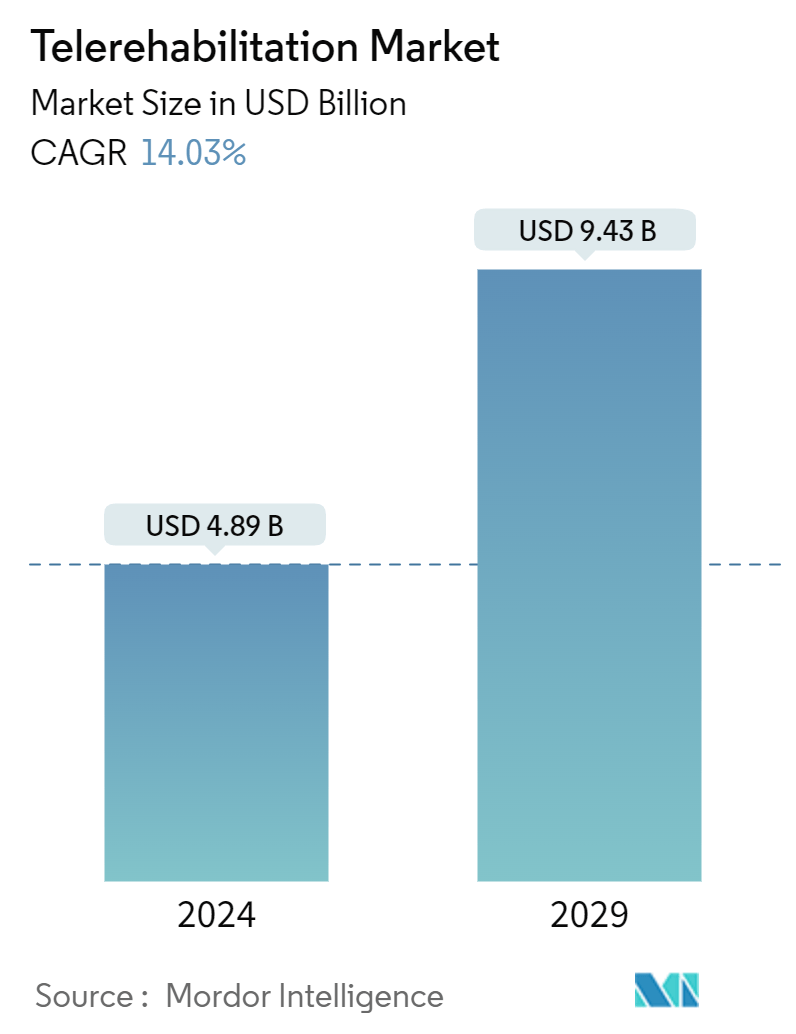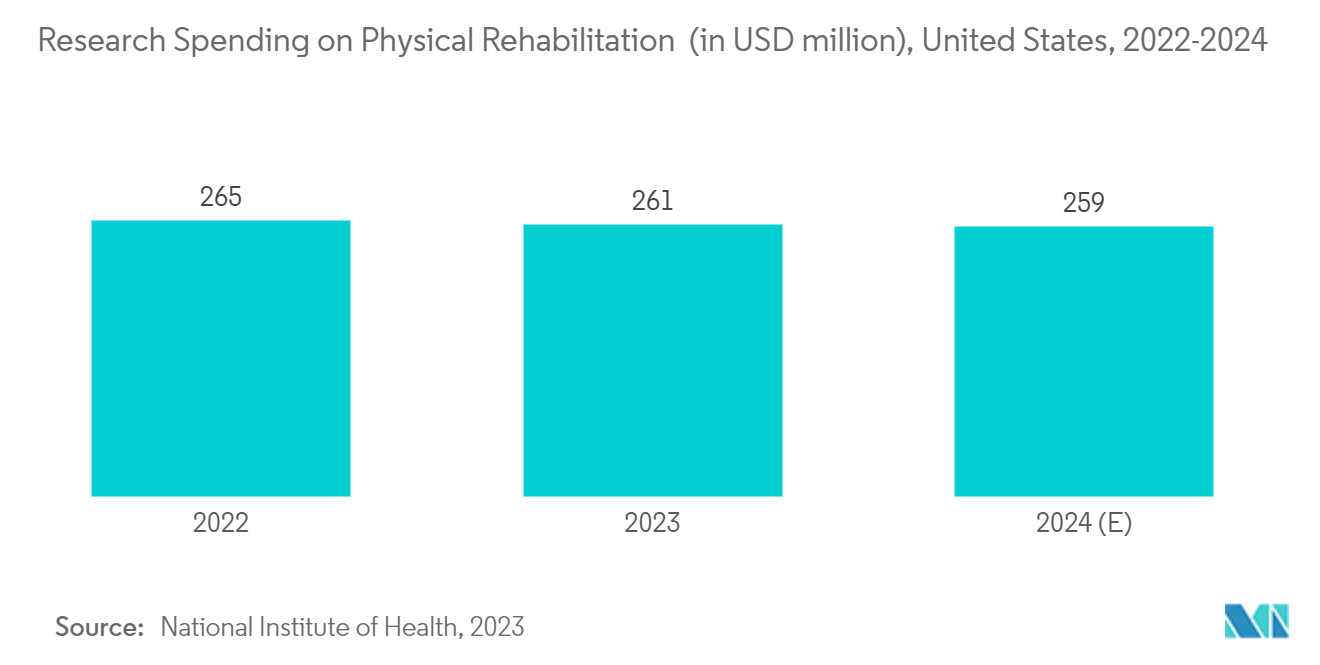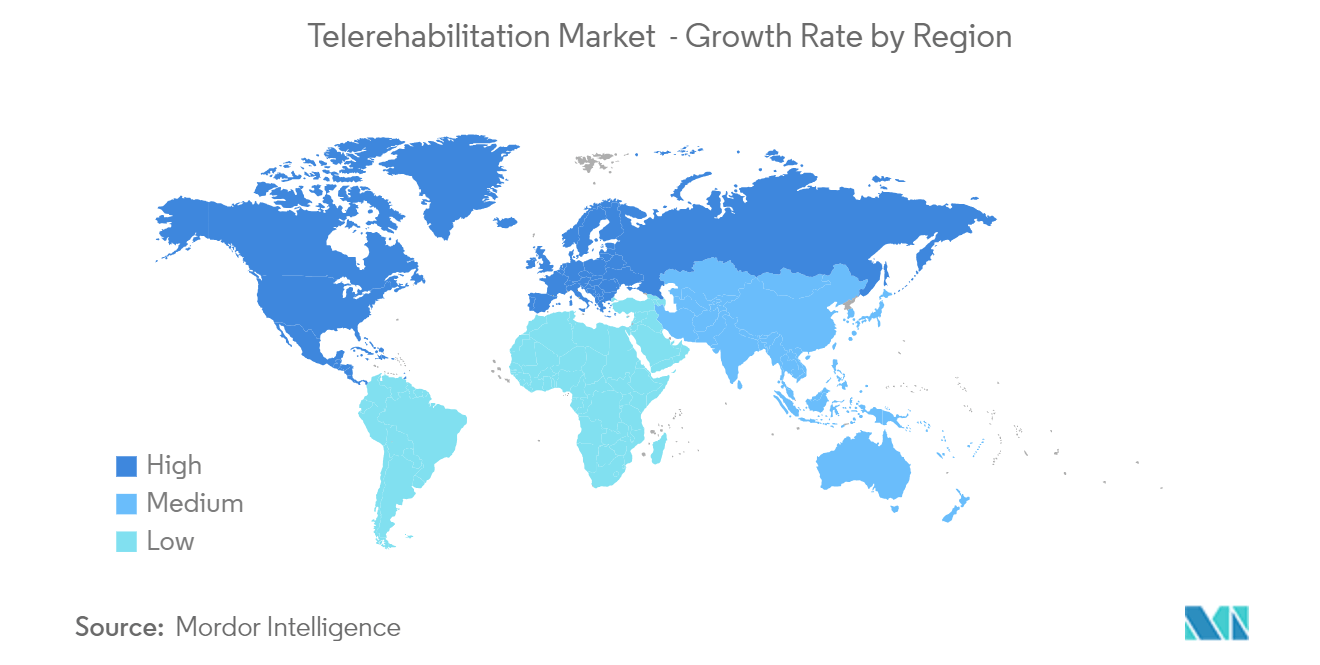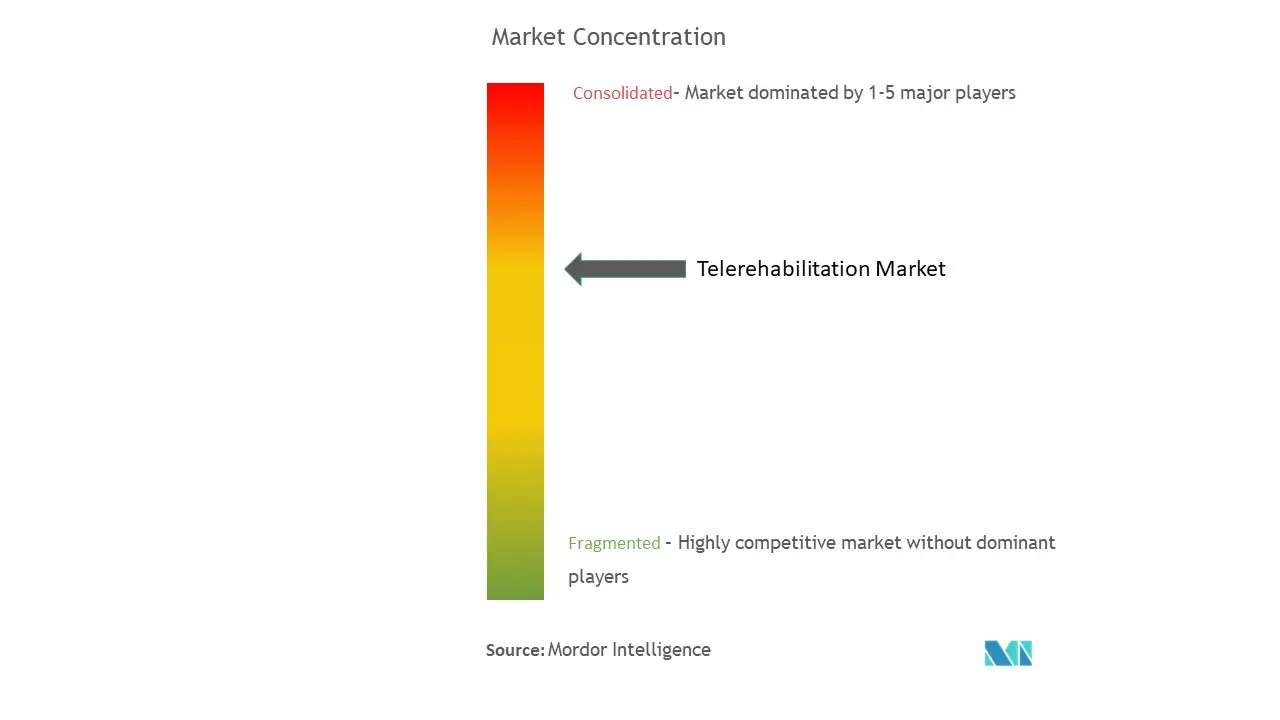Telerehabilitation Market Size

| Study Period | 2019 - 2029 |
| Market Size (2024) | USD 4.89 Billion |
| Market Size (2029) | USD 9.43 Billion |
| CAGR (2024 - 2029) | 14.03 % |
| Fastest Growing Market | Asia Pacific |
| Largest Market | North America |
Major Players
*Disclaimer: Major Players sorted in no particular order |
Telerehabilitation Market Analysis
The Telerehabilitation Market size is estimated at USD 4.89 billion in 2024, and is expected to reach USD 9.43 billion by 2029, growing at a CAGR of 14.03% during the forecast period (2024-2029).
The telerehabilitation market is influenced by multiple factors that are responsible for changing the way healthcare is delivered and accessed. Firstly, the growing prevalence of chronic disorders and musculoskeletal disorders has created a burgeoning demand for rehabilitation services, making telerehabilitation an attractive solution for convenient and continuous care. Secondly, advancements in technology, particularly in telecommunication infrastructure and wearable devices, have enabled real-time monitoring and remote guidance, enhancing the effectiveness of rehabilitation programs. Furthermore, the growing aging population, together with the shortage of healthcare professionals, has influenced healthcare providers to look for telehealth options to reach areas that lack healthcare services.
Telerehabilitation offers convenience to patients who can receive therapy from the comfort of their homes, reducing the need for travel and saving time. According to the article published by the International Journal of Environmental Research and Public Health in April 2022, telerehabilitation has become increasingly prevalent worldwide, particularly in the rehabilitation of geriatric populations, bridging the gap between healthcare professionals and older adults. Thus, telerehabilitation offers significant benefits to geriatric populations by providing convenient access to rehabilitation services from home, reducing logistical barriers, and improving overall patient compliance and outcomes.
Furthermore, according to the World Social Report 2022 by the Department of Economic and Social Affairs of the United Nations, the percentage of people who fall under the age group of 65 years and above is estimated to rise from 10% in 2022 to 16% in 2050 of the total global population. Therefore, factors like the effectiveness of telerehabilitation services for the geriatric population and the growing geriatric population are expected to further contribute to the growth of the market in the coming years.
Apart from this, the continuous improvement in internet connectivity, video conferencing platforms, and mobile devices has made it simpler for healthcare practitioners to deliver telerehabilitation services. High-quality video and audio communication are essential for effective remote rehabilitation. According to one of the articles published by Frontiers in February 2022, tele-exercise studies involving direct or indirect supervision with the use of webcams, video calls, phone calls, and smartphone applications have achieved comparable improvement results compared to the results through in-person rehabilitation from clinics or hospitals. This is expected to be a driving force for the growth of the market during the forecast period.
Therefore, owing to factors such as the rise in the geriatric population and advancements in the telemedicine field, the market is expected to grow during the forecast period. However, factors like privacy and data security concerns and limited patient access to technology can limit the growth of the market in the coming years.
Telerehabilitation Market Trends
The Physiotherapy Rehabilitation (Orthopedic) Segment is Expected to Hold a Significant Market Share During the Forecast Period
- Physiotherapy rehabilitation (orthopedic), often referred to simply as physiotherapy or physical therapy, is focused on helping individuals recover from injuries, illnesses, or surgeries that affect their physical function. This segment is expected to contribute a significant share of the market because of factors like the high burden of musculoskeletal disorders, high cases of trauma, and increased requirements for rehabilitation while combating muscular disorders.
- Due to the increasing prevalence of musculoskeletal disorders around the world, the need for rehabilitation increases. As per one of the articles published by the Australian Institute of Health and Welfare in June 2023, there were around 699,431 people who had disabilities due to musculoskeletal disorders in 2022. As per one of the articles published by the Archives of Physiotherapy Journal in January 2023, telerehabilitation is crucial for improving healthcare outcomes concerning patients suffering from musculoskeletal disorders. So, the increasing prevalence of musculoskeletal disorders further increases the requirements for rehabilitation, and since telerehabilitation has been considered an effective means of healthcare delivery, this would eventually lead to the growth of this segment in the coming years. These factors also make this segment a dominant one.
- Apart from this, the research activities going on with respect to telerehabilitation for orthopedic conditions are expected to further contribute to the growth of this segment. For instance, in the article published by BioMedical Engineering OnLine in October 2023, telerehabilitation showed beneficial effects on walking ability, knee extension, and costs among patients who underwent total knee arthroplasty (TKA) in this research. It further highlighted that telerehabilitation has proven to be as effective as traditional rehabilitation methods in improving patients' quality of life. Studies examining its safety and efficacy are on the rise, especially among patients recovering from total knee arthroplasty (TKA). This highlighted telerehabilitation's potential in the physiotherapy rehabilitation (orthopedic) segment, showcasing its ability to deliver comprehensive care remotely for post-surgical recovery and functional enhancement. Thus, the rising research activities for telerehabilitation are anticipated to fuel the growth of the segment during the forecast period.
- Hence, the rising burden of musculoskeletal disorders and developments in the field of telerehabilitation concerning orthopedic conditions are expected to drive the growth of this segment in the market.

Asia-Pacific is Expected to Grow at a Significant Rate During the Forecast Period
- Asia-Pacific is expected to experience a substantial growth rate in the telerehabilitation market during the forecast period. This is due to several factors, like a surge in the cases of cancer, an increase in the number of elderly people, multiple developments related to telerehabilitation, and an increased use of digital technologies for rehabilitation in this region.
- Various services are offered through cancer telerehabilitation, which includes skilled therapies, physiatry services, symptom management, exercise-based interventions, and support groups. Since the prevalence of cancer is quite high in this region, this is expected to be an attractive market. For instance, as per an article published by the Australian Institute of Health and Welfare in August 2023, there will be more than 200,000 cases of cancer in Australia by 2033. This is one of the crucial factors that would be responsible for the market's growth in this region.
- The launches of telerehabilitation services or software in this region have had a significant impact on the growth of the Asia-Pacific market. For instance, in the early months of 2022, HI launched a telerehabilitation software called OpenTeleRehab in Vietnam. HI is an aid organization that received recognition for its multidisciplinary telerehabilitation software program called OpenTeleRehab software in November 2022. In reference to the Digital Public Goods Standard, this software was recognized as a Digital Public Good. Therefore, developments like these are expected to further expand the growth of this market in this region.
- Hence, owing to factors such as the launches of telerehabilitation software and the rising incidence of cancer, the market studied is expected to grow at a significant rate in Asia-Pacific.

Telerehabilitation Industry Overview
The telerehabilitation market is concentrated. Companies in this market usually form partnerships with healthcare providers, hospitals, insurers, and rehabilitation centers. These collaborations help them to expand their reach and integrate their services into existing healthcare ecosystems. Some key players are American Well, Koninklijke Philips NV, Tunstall Group, Teladoc Health Inc., and Hinge Health Inc.
Telerehabilitation Market Leaders
-
American Well
-
Koninklijke Philips N.V.
-
Tunstall Group
-
Teladoc Health, Inc.
-
Hinge Health, Inc.
*Disclaimer: Major Players sorted in no particular order

Telerehabilitation Market News
- March 2023: NeuroTechR3 Inc., in collaboration with various researchers, published a publication to verify the validity of utilizing R3THA’s assessment protocol for telerehabilitation in a lab-based scenario.
- January 2023: A large-scale, randomized clinical study was initiated to test the effectiveness and feasibility of the COCARE system, which is a technology-driven solution for the treatment of the geriatric population and rehabilitation pathways.
Telerehabilitation Market Report - Table of Contents
1. INTRODUCTION
- 1.1 Study Assumption and Market Definition
- 1.2 Scope of the Study
2. RESEARCH METHODOLOGY
3. EXECUTIVE SUMMARY
4. MARKET DYNAMICS
- 4.1 Market Overview
-
4.2 Market Drivers
- 4.2.1 Burden of Chronic Diseases and Growing Geriatrics Population
- 4.2.2 Advantages and Convenience Associated with Telerehabilitation
- 4.2.3 Advancements in Telemedicine Technology and Launch of Telerehabilitation Services
-
4.3 Market Restraints
- 4.3.1 Limited Patient Access to Technology
- 4.3.2 Privacy and Data Security Concerns
-
4.4 Porter's Five Forces Analysis
- 4.4.1 Threat of New Entrants
- 4.4.2 Bargaining Power of Buyers/Consumers
- 4.4.3 Bargaining Power of Suppliers
- 4.4.4 Threat of Substitute Products
- 4.4.5 Intensity of Competitive Rivalry
5. MARKET SEGMENTATION (Market Size by Value - USD)
-
5.1 By Component
- 5.1.1 Software and Services
- 5.1.2 Hardware
-
5.2 By Mode of Delivery
- 5.2.1 Cloud-based
- 5.2.2 On-premise
-
5.3 By Application
- 5.3.1 Cardiac Rehabilitation
- 5.3.2 Neurological Rehabilitation
- 5.3.3 Physiotherapy Rehabilitation (Orthopedic)
- 5.3.4 Cancer
- 5.3.5 Other Applications
-
5.4 By Geography
- 5.4.1 North America
- 5.4.1.1 United States
- 5.4.1.2 Canada
- 5.4.1.3 Mexico
- 5.4.2 Europe
- 5.4.2.1 Germany
- 5.4.2.2 United Kingdom
- 5.4.2.3 France
- 5.4.2.4 Italy
- 5.4.2.5 Spain
- 5.4.2.6 Rest of Europe
- 5.4.3 Asia-Pacific
- 5.4.3.1 China
- 5.4.3.2 Japan
- 5.4.3.3 India
- 5.4.3.4 Australia
- 5.4.3.5 South Korea
- 5.4.3.6 Rest of Asia-Pacific
- 5.4.4 Middle East and Africa
- 5.4.4.1 GCC
- 5.4.4.2 South Africa
- 5.4.4.3 Rest of Middle East and Africa
- 5.4.5 South America
- 5.4.5.1 Brazil
- 5.4.5.2 Argentina
- 5.4.5.3 Rest of South America
6. COMPETITIVE LANDSCAPE
-
6.1 Company Profiles
- 6.1.1 American Well
- 6.1.2 Doctor On Demand by Included Health Inc.
- 6.1.3 Hinge Health, Inc
- 6.1.4 Jintronix
- 6.1.5 MIRA Rehab Limited
- 6.1.6 Koninklijke Philips NV
- 6.1.7 NeoRehab
- 6.1.8 Rehabtek LLC
- 6.1.9 Teladoc Health Inc.
- 6.1.10 Tunstall Group
- 6.1.11 RecoveryPlus.health
- 6.1.12 TRAK HEALTH SOLUTIONS SL
- 6.1.13 NeuroTechR3 Inc.
- *List Not Exhaustive
7. MARKET OPPORTUNITIES AND FUTURE TRENDS
** Subject To AvailablityTelerehabilitation Industry Segmentation
As per the scope of the report, telerehabilitation tools refer to a range of technological solutions and tools designed to provide remote rehabilitation services and support to individuals recovering from injuries, surgeries, or medical conditions. The telerehabilitation market is segmented into components, mode of delivery, application, and geography. By component, the market is segmented into software and services and hardware. By mode of delivery, the market is segmented into cloud-based and on-premise. By application, the market is segmented into cardiac rehabilitation, neurological rehabilitation, physiotherapy rehabilitation (orthopedic), cancer, and other applications. The other segments include pediatric rehabilitation and others. By geography, the market is segmented into North America, Europe, Asia-Pacific, the Middle East and Africa, and South America. For each segment, the market sizing and forecasts were made based on value (USD).
| By Component | Software and Services | |
| Hardware | ||
| By Mode of Delivery | Cloud-based | |
| On-premise | ||
| By Application | Cardiac Rehabilitation | |
| Neurological Rehabilitation | ||
| Physiotherapy Rehabilitation (Orthopedic) | ||
| Cancer | ||
| Other Applications | ||
| By Geography | North America | United States |
| Canada | ||
| Mexico | ||
| By Geography | Europe | Germany |
| United Kingdom | ||
| France | ||
| Italy | ||
| Spain | ||
| Rest of Europe | ||
| By Geography | Asia-Pacific | China |
| Japan | ||
| India | ||
| Australia | ||
| South Korea | ||
| Rest of Asia-Pacific | ||
| By Geography | Middle East and Africa | GCC |
| South Africa | ||
| Rest of Middle East and Africa | ||
| By Geography | South America | Brazil |
| Argentina | ||
| Rest of South America |
Telerehabilitation Market Research FAQs
How big is the Telerehabilitation Market?
The Telerehabilitation Market size is expected to reach USD 4.89 billion in 2024 and grow at a CAGR of 14.03% to reach USD 9.43 billion by 2029.
What is the current Telerehabilitation Market size?
In 2024, the Telerehabilitation Market size is expected to reach USD 4.89 billion.
Who are the key players in Telerehabilitation Market?
American Well, Koninklijke Philips N.V., Tunstall Group, Teladoc Health, Inc. and Hinge Health, Inc. are the major companies operating in the Telerehabilitation Market.
Which is the fastest growing region in Telerehabilitation Market?
Asia Pacific is estimated to grow at the highest CAGR over the forecast period (2024-2029).
Which region has the biggest share in Telerehabilitation Market?
In 2024, the North America accounts for the largest market share in Telerehabilitation Market.
What years does this Telerehabilitation Market cover, and what was the market size in 2023?
In 2023, the Telerehabilitation Market size was estimated at USD 4.20 billion. The report covers the Telerehabilitation Market historical market size for years: 2019, 2020, 2021, 2022 and 2023. The report also forecasts the Telerehabilitation Market size for years: 2024, 2025, 2026, 2027, 2028 and 2029.
Telerehabilitation Industry Report
Statistics for the 2024 Telerehabilitation market share, size and revenue growth rate, created by Mordor Intelligence™ Industry Reports. Telerehabilitation analysis includes a market forecast outlook for 2024 to 2029 and historical overview. Get a sample of this industry analysis as a free report PDF download.



